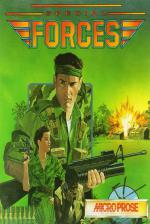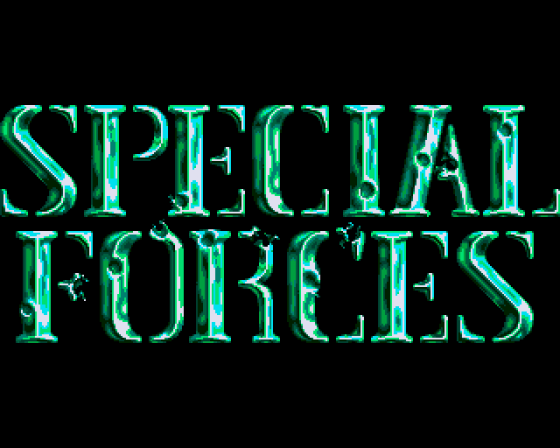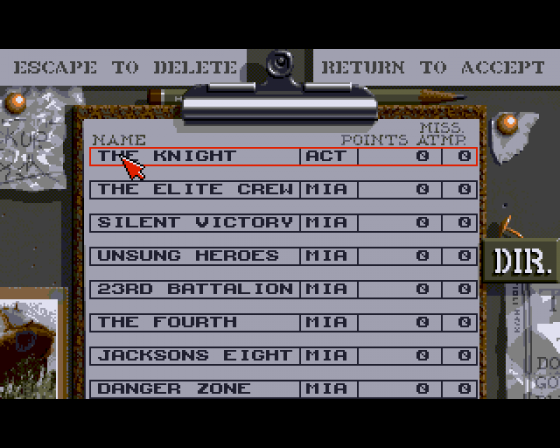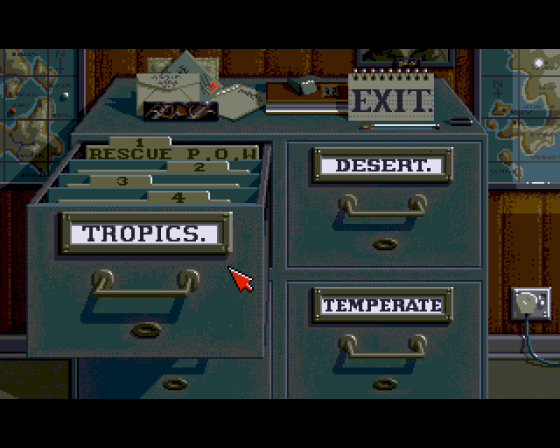
Amiga Power
 1st April 1992
1st April 1992
Categories: Review: Software
Author: Matthew Squires
Publisher: Microprose
Machine: Amiga 500
Published in Amiga Power #12
MicroProse give their epic 3D flight sims a rest to take us on a trip deep into enemy territory, Airborne Ranger-style. But is Special Forces really that special?
Special Forces
MicroProse haven't put a foot wrong in recent months - indeed, what other publisher could boast such an unbroken stream of top quality products throughout the last year? Not Mindscape, not Psygnosis, and certainly not Electronic Arts - so it was with eager anticipation that I snatched the chance to review this newie. It's one of their military-strategy-with-action-bits games, a spiritual descendant of the ageing Airborne Ranger - and as such perhaps not of the same surefire hit quality as great simulations like Knights Of The Sky or Formula One Grand Prix - though expectations still ran high. This, then, is the story of how a MicroProse game teased me, confused me, and eventually disappointed me, and as such won't make for pretty reading. This is not a game I had fun with.
First Blood: The First Chapter
But first, what's it all about? Newish readers will probably be having real problems at this point - if it's a MicroProse game, how come it doesn't have solid 3D graphics, I can hear them asking - so it's probably best explained as an elaborately executed strategy game. Following a game style established in Airborne Ranger, Special Forces put you in charge of a small team of elite troops, teaches you how to control them, and then launches you into a series of missions, each with its own environment to explore and individual skills to be mastered.
The introductory sequence boasts only average animation, despite the scenes being effectively illustrated, and this unfortunately sets the pace. It shows the Special Forces chopper flying to its destination, dropping off your four soldiers (they abseil to the ground, then walk off into the jungle) before finishing on a military style screen of the Special Forces logo being shot to bits with machine gun fire. Very ho hum stuff.

Immediately after, though, things get briefly better. This being a MicroProse game, there are certainly a wealth of options on offer - including four levels of mission difficulty to select. The first batch of missions, dubbed 'conscript', give you targets clearly mapped out for you before you set off, badly equipped and ill-trained opponents, and should generally be a breeze to complete. Less so the 'regular missions, where objectives are given using a grid reference system and the enemy are trained but inexperienced. Once you have mastered the first two levels, things get really serious though - the 'veteran' scenarios provide mission objectives not shown on your maps and put you up against highly skilled experienced soldiers. And if you think that sounds tough, wait until you get to the 'elite' section...
Once you've chosen your difficulty level it's onto the mission screen, and, more specifically, to a filing cabinet containing four drawers, marked Tropics, Arctic, Desert and Temperate. Click on one of these and it opens to reveal four mission documents. Pick the one you fancy - it could be destroying drug rings, blowing up scud units or busting tanks - then whiz off to select the squad of soldiers you'll be sending on the mission. A quick read through the various blokes' stats, an even quicker allocation of code names (a choice of Stark, Cobra, Tiger and Eagle) and you're off. You pick a squad of eight and then decide which four to take on any one mission - if any get killed, you're obviously got rather fewer to choose between next time round. Only when all eight guys are dead do you get to restock your squad of guys.
First Blood: The Second Chapter
Hold your itchy feet just a minute though - we're not ready to take the mission jusy tet! (What d'you think this is, an arcade game?) First you've got to rig the boys up with a choice of guns and ammo. An anti-tank mission, for instance, will require a goodly selection of remotely detonateable explosives - though, of course, you can go for the default selections if you're feeling lazy. And that's basically it - your team is now ready for the war zone. Time to pick the point where you want your chopper to drop the boys off.

Oi! Wake up, you 'orrible lot! Yes, you who've been dozing for the last few paragraphs, it's time to sit up and pay attention - we're about to get into the actual game now. The whole thing operates using a top-down plan view of the small area around your troops. In looks it all treads a fine line between an arcade game style and 'realism' - MicroProse have coloured your unit to blend very nicely into the forest background in their natty green outfits, while at the same time making sure the sprites are bold enough that they don't get completely lost in the undergrowth. You could argue that, visually, it's a little dull, but MicroProse's audience is one that would react badly to anything that smacked of Commando or similar, and I think they've drawn the line rather well.
Clarity could be better, however - some objects (targets like Scud missile carriers and tanks, particularly) are very clear on screen, though other bits get confusing and force you to keep referring back to the map. Your lead man (if can be any of the four) is indicated by a crossed swords symbol - you simply move it around with the joystick and he (and, if you've selected them, the others) will follow.
Choosing between your weapons and swapping them around for each soldier is easy and efficient - tapping a single key will cycle through the weapon icons at the bottom of the screen - and while animation and so on is generally less than spectacular, it's perfectly serviceable. However, this degree of usability isn't carried through to the rest of the controls, a point we'll get onto in a minute.
Team Spirit And All That Stuff

Perhaps the most important single aspect of the game is that you're meant to split your men up and control them all separately, constantly juggling between them as the game progresses. Unlike in many FRPs and similar, though, you get the chance to see all four men at once even when they're not travelling together - the screen can be split into four quarters, each mini-window showing the individual position of each team member. There are no labels or symbols on each of these to inform you who's who though, which means you're going to spend a while mucking about with the function keys while you try to gain control of the soldier you want.
Once you're used to it, this function supplies the core of the game's interest - keeping track of each of your four little men, making sure they're all safe and all serving a useful task in the mission, is where it comes alive. If only they'd paid a bit more attention to the intuitiveness to the control, you can't help but wonder if we'd have had quite a game on our hands here...
That's the problem, you see - you're going to have to be a dab hand at juggling joystick/mouse with a keyboard if you're going to get anything out of this game. The basic game is simple, rather old fashioned even - effectively the same thing as an RPG like Shadowlands, but without all the imaginative possibilities magic brings - but with so many different keys controlling so many functions it all becomes much more complex than is friendly or, indeed, it needs to be. With most of the keyboard functions presented as on-screen icons instead, which could be selected with a click of the mouse or joystick, it would become a much more accessible game. As it is, managing to successfully combine moving all four guys with keeping tabs on the main map screens with sussing out enemy positions with goodness-knows what is possible, but demands a degree of co-ordination and frustration-resistance beyond most of us.
Apocalypse Any Moment Now

Conclusion time then. Special Forces does have a fair amount going for it - some professional presentation, a lot of variety in the different levels (Sixteen missions to choose from across four climatic regions), plenty of options and moments of high drama and great excitement. However, it also has a number of problems - it's actually a fairly simple game idea deliberately over-complicated with options, unfriendly controls and so on, and it's obviously not quite sure about whether it wants to be an arcade game or a strategy thing. It walks an uneasy line between the two, and in doing so - both in concept and execution - falls well short of what we've come to expect from MicroProse. They have never seemed very comfortable when they've moved away from military equipment simulations, and nothing's changed here.
Only really recommendable if you're absolutely, positive certain you like 'that sort of thing'...
The Bottom Line
Uppers: An updated Airborne Ranger, and as such as Godsend for fans. There's plenty of variety and scope to the different missions on offer here, the usual MicroProse array of options adding depth to something highly reminiscent of a po-faced RPG, but without the magic.
Downers: Unimaginative sound effects and graphics disappoint, but it's the ill thought-out complexity of the controls that really do the playability no favours. Underneath it all, a very old-fashioned game.
MicroProse have never looked happy with non-simulation games, and it doesn't look like the old dog's learned any new tricks here. Not exactly ill-thought-out, but certainly a very average and unenthralling military shoot-'em-up/strategy game thingy.


















